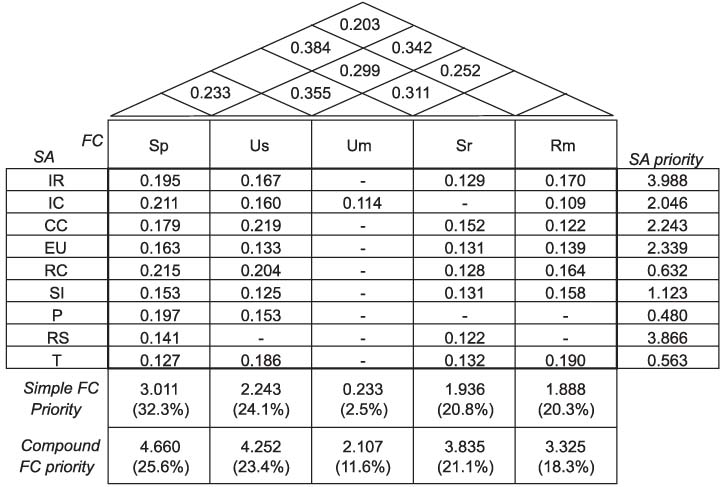Healthc Inform Res.
2010 Mar;16(1):6-14. 10.4258/hir.2010.16.1.6.
A Quality Function Deployment Framework for the Service Quality of Health Information Websites
- Affiliations
-
- 1Department of Health Services Management, School of Management, Kyung Hee University, Seoul, Korea. hjchang@khu.ac.kr
- 2Department of Management, School of Management, Kyung Hee University, Seoul, Korea.
- KMID: 2166560
- DOI: http://doi.org/10.4258/hir.2010.16.1.6
Abstract
OBJECTIVES
This research was conducted to identify both the users' service requirements on health information websites (HIWs) and the key functional elements for running HIWs. With the quality function deployment framework, the derived service attributes (SAs) are mapped into the suppliers' functional characteristics (FCs) to derive the most critical FCs for the users' satisfaction. METHODS: Using the survey data from 228 respondents, the SAs, FCs and their relationships were analyzed using various multivariate statistical methods such as principal component factor analysis, discriminant analysis, correlation analysis, etc. Simple and compound FC priorities were derived by matrix calculation. RESULTS: Nine factors of SAs and five key features of FCs were identified, and these served as the basis for the house of quality model. Based on the compound FC priorities, the functional elements pertaining to security and privacy, and usage support should receive top priority in the course of enhancing HIWs. CONCLUSIONS: The quality function deployment framework can improve the FCs of the HIWs in an effective, structured manner, and it can also be utilized for critical success factors together with their strategic implications for enhancing the service quality of HIWs. Therefore, website managers could efficiently improve website operations by considering this study's results.
MeSH Terms
Figure
Reference
-
1. Eysenbach G. Consumer health informatics. BMJ. 2000. 320:1713–1716.2. Dyer KA. Ethical challenges of medicine and health on the internet: a review. J Med Internet Res. 2001. 3:E23.
Article3. Baker L, Wagner TH, Singer S, Bundorf MK. Use of the internet and e-mail for health care information: results from a national survey. JAMA. 2003. 289:2400–2406.
Article4. Ybarra ML, Suman M. Help seeking behavior and the internet: a national survey. Int J Med Inform. 2006. 75:29–41.
Article5. Fox S, editor. Online health search 2006: Most internet users start at a search engine when looking for health information online: very few check the source and date of the information they find [Internet]. 2006. cited 2010 Mar 16. Washington (DC): Pew Internet & American Life Project;Available from: http://www.pewinternet.org/~/media//Files/Reports/2006/PIP_Online_Health_2006.pdf.pdf.6. Sillence E, Briggs P, Harris PR, Fishwick L. How do patients evaluate and make use of online health information? Soc Sci Med. 2007. 64:1853–1862.
Article7. Rodrigues RJ. Ethical and legal issues in interactive health communications: a call for international cooperation. J Med Internet Res. 2000. 2:E8.
Article8. Kang N, Kim J, Tack G, Hyun T. Criteria for the websites in Korean with health information on the internet. J Korean Soc Med Inform. 1999. 5:119–124.
Article9. Shin JH, Seo HG, Kim CH, Koh JS, Woo KH. The evaluation of scientific reliability of medical information on WWW in Korea through analyzing hepatitis information. J Korean Soc Med Inform. 2000. 6:73–88.
Article10. Chung YC, Park HA. Development of a health information evaluation system on the internet. J Korean Soc Med Inform. 2000. 6:53–66.
Article11. Kim J, Kim E, Ko I, Kang SM. An evaluation study of hypertension information providing web sites on the internet. J Korean Soc Med Inform. 2003. 9:45–52.
Article12. Centers for Medicare & Medicaid Services. Health insurance reform: security standards. Final rule. Fed Regist. 2003. 68:8334–8381.13. Risk A, Petersen C. Health information on the internet: quality issues and international initiatives. JAMA. 2002. 287:2713–2715.14. Franceschini F, Rossetto S. QFD: the problem of comparing technical engineering design requirements. Res Eng Design. 1995. 7:270–278.15. Franceschini F, Rupil A. Rating scales and prioritization in QFD. Int J Qual Reliab Manag. 1999. 16:85–97.
Article16. Franceschini F, Rossetto S. Quality function deployment: how to improve its use. Total Qual Manag. 1998. 9:491–500.
Article17. Hauser JR, Clausing D. The house of quality. Harv Bus Rev. 1988. 66:63–73.18. Tan KC, Xie M, Chia E. Quality function deployment and its use in designing information technology system. Int J Qual Reliab Manag. 1998. 15:634–645.
Article19. Chang H, Shim J, Kim Y. Sources of health information by consumer's characteristics. J Korean Soc Med Inform. 2004. 10:415–427.
Article20. Chang H, Kim D, Shim J. Attributes of user-centered evaluation for health information websites. J Korean Soc Med Inform. 2004. 10:429–440.
Article21. Jadad A, Gagliardi A. Rating health information on the internet: navigating to knowledge or to Babel? JAMA. 1998. 279:611–614.22. Pealer LN, Dorman SM. Evaluating health related web sites. J Sch Health. 1997. 67:232–235.
- Full Text Links
- Actions
-
Cited
- CITED
-
- Close
- Share
- Similar articles
-
- Application of the HoQ Model to Operations of Health Information Websites
- Attributes of User-centered Evaluation for Health Information Websites
- Quality Evaluation of Online Health Information Related to Young Child
- Assessing the Quality of Internet Health Information Using DISCERN
- The quality of non-alcoholic fatty liver disease information resources for patients on the internet in Korea


